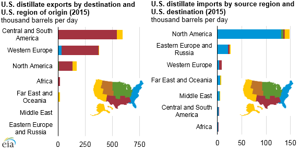EIA: US exports distillate from Gulf Coast, imports on East Coast
US distillate exports increased 85 Mbpd in 2015, reaching nearly 1.2 MMbpd. Distillate exports in the first six months of 2016 have averaged 50 Mbpd more than in the first half of 2015. US distillate imports, which are relatively fewer, averaged 200 Mbpd in 2015 and 157 Mbpd in the first half of 2016. Patterns of US distillate trade can be explained by regional supply and demand imbalances within the East Coast and Gulf Coast regions.
Exports of distillate are the largest component of US petroleum product exports and have averaged at least 1 MMbpd since 2012. The US exported distillate fuel to 88 countries in 2015, with the largest portion heading to countries in Central and South America. Unlike motor gasoline, which is used almost exclusively for transportation, distillate fuel has a variety of uses, including as a heating fuel in homes and businesses, as a fuel for certain industrial processes, and as a transportation fuel for both light- and heavy-duty vehicles.
The US Gulf Coast (Petroleum Administration for Defense District, or PADD, 3) is the largest petroleum refining region in the country, accounting for more than half of US refining capacity in 2015. Distillate production on the US Gulf Coast exceeds regional demand, making the region a net supplier to other US regions and foreign markets. In 2015, refineries in the region produced nearly 2.8 MMbpd of distillate, while regional demand was only 792 Mbpd. The Gulf Coast accounted for 87% of US distillate exports in 2015.
East Coast distillate production is below regional demand, and the region accounted for 85% of total US distillate imports in 2015. Demand for distillate (which includes heating oil) is seasonal in the Northeast, where23% of households use oil for space heating (compared to 5% of households nationwide that use heating oil). The East Coast typically imports distillate in the winter months to meet higher demand but may export distillate in the warmer summer months.
A significant portion of East Coast distillate demand is met with product produced on the Gulf Coast, and movement of distillate from the Gulf Coast to the East Coast (881 Mbpd in 2015) represents the largest inter-PADD movement of distillate within the US. However, movement of distillate is affected by transportation constraints and shipping regulations. Pipelines between the Gulf Coast and East Coast already operate at or near full capacity, while maritime regulations add to the cost of marine movements between US ports.







Comments